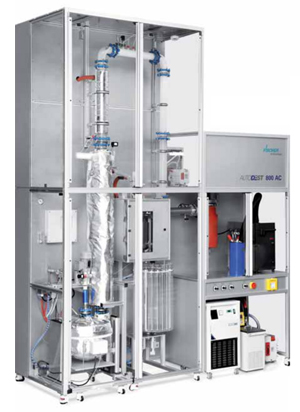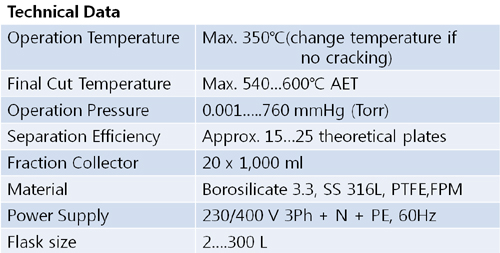|


A new Iludest distillation plant extends the limits of what is possible and
enables the extremely pure separation of bitumen fractions in a packed
distillation column — In this way the process engineers from Waldbüttelbrunn
defy the thermodynamic limits of the ASTM Standards D2892 and
D5236, and bring two seemingly incompatible requirements under one hat.
Bitumen fractions with challenging boiling requirements and characterized by low
overlapping fractions require a high separation capacity of the columns and high
temperatures that can be achieved only under high vacuum conditions. “These are
conditions which cannot be satisfied so far with the parameters specified by the
D2892 and D5236 standards”, says Dr.-Ing. Hans-Eckhard Koenen (Engineer), Team
Leader “Thermodynamics” at IIudest/i-Fischer. For the delivery of this
particular customer demand, the Waldbüttelbrunn Company who devised the solution
has received the “PROCESS Innovation Award” at Achema, the second within the
intervening period. The seven strong team of IIudest/i-Fischer engineers has
managed to reinvent distillation again and again. This time round, the Fischer
Autodest 800AC/HV has put the competition in its place. The special features of
the distillation plant are that this apparatus covers a temperature range which
extends the range of the ASTM Standards D2892 and D5236 still further—and that
too in a single packed column at a vacuum down to 10-3 Torr. The system therefore
exceeds the boiling point of the bitumen fraction, i.e., achieves a temperature
range of 560 to 600°C (equivalent to atmospheric pressure) This is clear if one
examines the thermodynamic definitions of the two standards more closely, and
this is what the team of engineers has actually done.
• ASTM D2892 is based on a packed column with a theoretical separation capacity of
15 theoretical plates, operated at a vacuum of 2 Torr and a boiling point of
400°C (at atmospheric pressure).
• In comparison ASTM D5236 is based on an open tubular column, a theoretical
separation capacity of 2 theoretical plates, operated at 0.1 Torr, with a maximum
boiling point range of 540 to 565°C (at atmospheric pressure).
On the crucial point of getting both standards under one hat, Koenen says: “High
separation capacities are possible only with packed columns, but high temperatures
are possible only with open tubular columns, because a deeper lower vacuum is
possible here.” In other words, if one wants to outsmart thermodynamics, one must
develop distillation units that can withstand a high vacuum, because lower process
temperatures are possible only at higher vacuum levels. Finally, the hydrocarbon
chains crack at above 300°C, a process which one must avoid during crude oil
distillation. The incentive for the development came from two customer requests,
which followed one after the other in brief succession. Meanwhile, the first
prototype is already in use at a German petrochemicals company, whose request had
initiated the development in the first place. The units installed there achieve a
temperature of 560°C atmospheric equivalent, which corresponds to an operating
vacuum of 0.1 Torr and achieve the theoretical separation capacity of 25
theoretical plates (also under vacuum). The winning Autodest 800AC/HV, which was
commissioned for a company in South Africa, tops in performance once again with a
maximum boiling point of 600°C atmospheric equivalent, and a separation capacity
of 30 theoretical plates. Such temperatures can be achieved only with a vacuum of
10-3 Torr, i.e., under the operating conditions of a short-cut path evaporator.
The challenge is described by Koenen and CEO Stefan Opis as follows:
“Thermodynami-cally, the requirements were mutually contradictory: The column
design requires a vacuum of 10-3 Torr and the fraction volumes required for the
separation capacity had to be bigger than the column hold-up volume.” If the
preceding order, which had paved the way for this requirement, had not come
through—who knows, perhaps the process engineers would have thrown in the towel.
“According to the available experience values, we knew that a column design was
possible”, says Koenen. The biggest challenge was the vacuum system. It became clear
to the process engineers rather fast that a normal oil diffusion pump would have
reached its limits. “We had to file the pipe sections and overcome turbulences
which would have caused a pressure fall drop”, explains Koenen. But the
calculations matched during the very first run, and the trial distillation was
successful.
|









